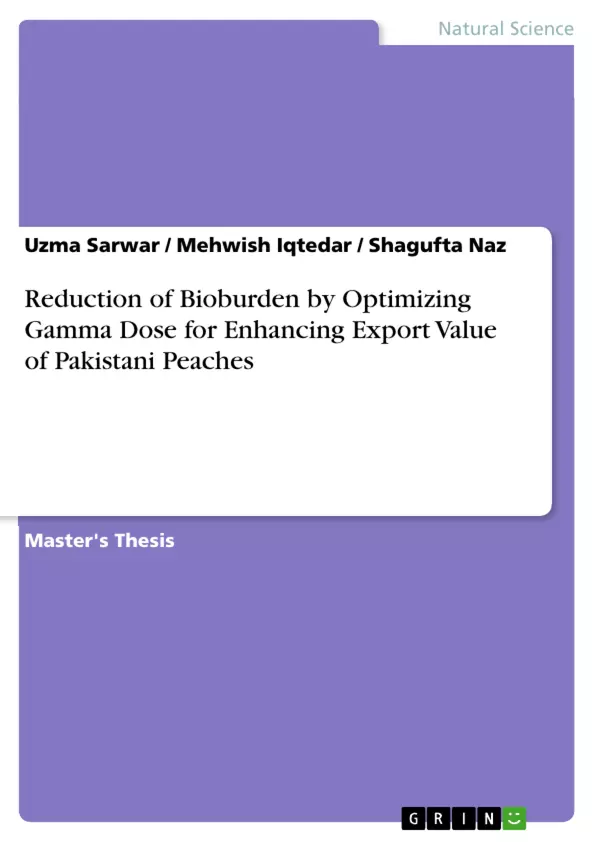Peach is the most commonly eaten stone fruit which grows in the temperate regions of
the world. These are also among the most exported fruits in term of volume and value.
Peaches, being perishable and susceptible to microbial spoilage, have a short shelflife.
The goal of this study was to determine the effect of gamma irradiation on the
microbiological and organoleptic properties of peaches and secondly, to determine the
effects of irradiation on shelf-life of the fruit. The fruit (local variety, No.4), at proper
maturity stage was collected and irradiated with 0.25, 0.5, and 0.75kGy dose, stored
under refrigerated (4
o
C) conditions for a period of three weeks. Total viable count,
Gram negative Enterobacteriaceae count, Salmonella-Shigella count, yeast and mold
count, loss in weight and decay percentage was evaluated after 7, 14 and 21 days of
storage (4
o
C). Data obtained from microbiological and sensory evaluations of
irradiated peaches was compared with the observations obtained from unirradiated
(control) samples. Microbial evaluation of the fruits revealed the presence of
Salmonella sonnie on SS agar and non fermentor spp. on macConkey agar. Ten types
of yeasts were isolated on potato dextrose agar and analyzed microscopically. Studies
showed total bacterial, yeast and molds significantly decreased with increasing dose
level. The sensory evaluation of the fruits revealed that irradiation preserves the
texture and appearance of fruit. The gamma-irradiation dose of 0.75kGy proved to be
effective in reducing weight loss and significantly (p≤0.05) delaying the decaying of
the fruit by 7 days under refrigerated (4
o
C) conditions. Statistical studies were carried
out using Duncan’s multiple range test (DMRT) and means were separated by LSD at
5 %. It is hoped that this particular type of research will help in improving export
quality of peaches.
Inhaltsverzeichnis (Table of Contents)
- Abstract
- Chapter 1: Introduction
- Chapter 2: Literature Review
- Chapter 3: Materials and Methods
- Chapter 4: Results
- Chapter 5: Discussions
- References
Zielsetzung und Themenschwerpunkte (Objectives and Key Themes)
This research aims to explore the effectiveness of gamma irradiation as a method to reduce the bioburden of Pakistani peaches, ultimately enhancing their export value and shelf life.
- Impact of gamma irradiation on total bacterial count, Enterobacteriaceae count, and Salmonella-Shigella count in peaches
- Analysis of the effects of different gamma doses (0.25kGy, 0.5kGy, and 0.75kGy) on microbial reduction and decay
- Evaluation of the influence of gamma irradiation on the overall quality and storage life of peaches
- Identification of potential bacterial and fungal species present in the peaches
- Assessment of the efficacy of gamma irradiation as a post-harvest treatment for enhancing peach export potential
Zusammenfassung der Kapitel (Chapter Summaries)
- Chapter 1: Introduction This chapter sets the stage for the study by providing an overview of the global peach trade, emphasizing the importance of post-harvest treatments for maintaining quality and extending shelf life. It highlights the challenges posed by microbial spoilage and the need for effective methods to minimize bioburden.
- Chapter 2: Literature Review This chapter delves into the existing knowledge on gamma irradiation technology and its application in the food industry. It examines the benefits and drawbacks of gamma irradiation for controlling microbial growth and extending the shelf life of fruits.
- Chapter 3: Materials and Methods This chapter outlines the experimental methodology used in the study, including the selection of peach varieties, the irradiation process, and the microbiological analysis techniques employed. It details the procedures for assessing the impact of gamma irradiation on various microbiological parameters and the overall quality of the peaches.
- Chapter 4: Results This chapter presents the findings of the research, analyzing the effects of different gamma doses on the microbial load of peaches over a three-week storage period. It includes quantitative data on total bacterial counts, Enterobacteriaceae counts, Salmonella-Shigella counts, yeast and mold counts, and the percentage of decay and weight loss.
Schlüsselwörter (Keywords)
This research focuses on the keywords: gamma irradiation, bioburden reduction, peach quality, shelf life, microbial contamination, post-harvest treatment, food preservation, export potential, bacterial count, Enterobacteriaceae, Salmonella-Shigella, yeast and mold, decay, weight loss.
- Quote paper
- Uzma Sarwar (Author), Mehwish Iqtedar (Author), Shagufta Naz (Author), 2014, Reduction of Bioburden by Optimizing Gamma Dose for Enhancing Export Value of Pakistani Peaches, Munich, GRIN Verlag, https://www.grin.com/document/289112



